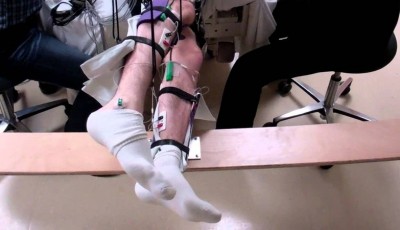Paralyzed Men Move Legs With New Non-Invasive Spinal Cord Stimulation
Five completely paralyzed patients were able to move their legs voluntarily for the very first time with the help of a new technique called transcutaneous stimulation, which combines non-invasive electrical stimulation, an experimental drug and physical therapy.
Scientists found that by the end of the 18-week study, and with the addition of serotonin med buspirone, the 5 men were able to move their legs with no stimulation.
While Professor Edgerton admits that we might be years away from having a final solution for patients with spinal cord injuries, he believes that their quality of life can definitely be improved until medicine reaches its destination.
In the most recent study, five men – each completely paralyzed from the waist down for more than 2 years – underwent a 45-minute training session per week for 18 weeks. Electrodes were place on the skin, at the lower back and near the tailbone, and the patients were given a unique, painless series of electrical currents. Edgerton emphasizes on how ridiculous these statements are because medicine evolved so much that we actually have the means to say that there is hope for paralyzed people to regain control of their own bodies.
Edgerton and his research team also plan to study people who have severe, but not complete, paralysis. They reported their results in the Journal of Neurotrauma.
The difference it that, previous to these experiments, movement was achieved by stimulating nerves with the help of devices designed to be surgically implanted into the spinal cord rather than simply be attached to the skin. “The potential to offer a life-changing therapy to patients without requiring surgery would be a major advance; it could greatly expand the number of individuals who might benefit from spinal cord stimulation”.
In this latest trial, the men were able to move while their legs were suspended in braces that hung from the ceiling.
Recordings of electrical signals in the men’s leg muscles increased while the amount of stimulation remained the same, suggesting communication between the brain and spine was being reestablished.
Despite the promise of noninvasive spinal cord stimulation, the researchers said surgically implanted devices may still be needed by some patients. Thus, they show that paralyzed individuals might regain at least some control over their limbs. Edgerton has investigated how paralysis can be alleviated. “It was remarkable”, Edgerton said, as he and most other experts in the field believed that those who suffered such an injury would no longer have such neural connections.
The researchers do not know yet whether patients who are completely paralysed can be trained to fully bear their weight and walk.
This research was supported in part by the National Institute of Biomedical Imaging and Bioengineering, the National Institute of Neurological Disorders and Stroke and the Eunice Kennedy Shriver National Institute of Child Health and Human Development, and the National Center for Advancing Translational Sciences at NIH under award numbers EB015521, EB007615, and TR000124, the Christopher and Dana Reeve Foundation, the Walkabout Foundation, and the F. M. Kirby Foundation, the Russian Foundation for Basic Research grant №13-04-12030, the Russian Scientific Fund project № 14-45-00024, the J. Yang and Family Foundation, and the Paul and Daisy Soros New American Fellowship.









